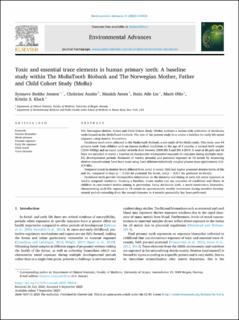Toxic and essential trace elements in human primary teeth: A baseline study within The MoBaTooth Biobank and The Norwegian Mother, Father and Child Cohort Study (MoBa)
Jensen, Synnøve Stokke; Austin, Christine; Arora, Manish; Lie, Stein Atle; Øilo, Marit; Klock, Kristin S.
Journal article, Peer reviewed
Published version

Åpne
Permanent lenke
https://hdl.handle.net/11250/3095521Utgivelsesdato
2023Metadata
Vis full innførselSamlinger
Sammendrag
The Norwegian Mother, Father and Child Cohort Study (MoBa) includes a nation-wide collection of deciduous teeth located in the MoBaTooth biobank. The aim of the present study is to create a baseline for early-life metal exposure using dentine biomarkers.
Deciduous teeth were collected in the MoBaTooth biobank, a sub-study of the MoBa-study. This study uses 94 primary teeth from children with no known medical conditions at the age of 6 months, a normal birth weight (2500-4500g) and an equal number of teeth shed between 2008-2013 and 2014-2019. A total of 48 girls and 46 boys are included to create a baseline to characterise retrospective exposure to toxicants during multiple early-life developmental periods. Estimates of weekly prenatal and postnatal exposure to 18 metals by measuring dentine concentrations have been made using laser ablation-inductively coupled plasma-mass spectrometry (LA-ICP-MS).
Temporal trends in dentine levels differed from metal to metal. Girls had higher postnatal dentine levels of Mn and Zn, compared to boys (p = 0.020 for postnatal Mn-levels, and p = 0.011 for postnatal Zn-levels).
Deciduous teeth provide retrospective information on the intensity and timing of early-life metal exposure at weekly temporal resolution. Creating a baseline, future studies can use outcomes of conditions and illness in children in case-control-studies aiming at prevention. Using deciduous teeth, a novel noninvasive biomarker, characterising early-life exposure to 18 metals in approximately weekly increments during sensitive developmental periods extending from the second trimester to 4 months postnatally has been performed.
